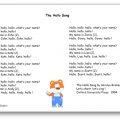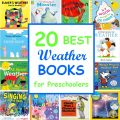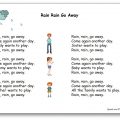Author: David Lloyd
Publisher: Lothrop, Lee and Shepard Books
Year: 1988
Language: English
Resource type: Children’s picture book
Themes: greetings, nature, weather cycle, simple interactions
Age range: 3–7 years
School levels: kindergarten (GS) to CE2 (Cycle 2 in France)
Main pedagogical goal: Practice simple English greetings and dialogue (Hello / Goodbye) in a natural context; develop listening and spoken interaction.
Summary
A tree stands in sunshine. A big brown bear arrives and says “Hello!” very loudly. Two bees fly by saying “Hello! Hello!” very busily. A big red bird joins in, saying “Hello!” quickly. Voices echo from leaves, branches, and roots—all saying “Hello!” Suddenly, a raindrop falls on the bear’s nose, then it rains all over. The bees and bird say “Goodbye!” and leave. The tree, alone again, whispers “Hello, rain!” very softly.
Culture and Vocabulary
- Nature vocabulary: tree, bear, bees, bird, rain, sunshine, drop, roots, branches.
- Greetings vocabulary: Hello, Goodbye, enhanced with adverbs (very loudly, very busily, very quickly, very quietly).
- Cultural aspect: simple social greetings in English, weather context (sun vs rain), familiar flora and fauna.
Grammar and Structures
- Short, repetitive exclamative sentences.
- Structure: “Hello!” / “Goodbye!” followed by said the X + adverb.
- Narrative inversion: “Suddenly, a drop of rain fell on the bear’s nose.”
- Simple possessive: the bear’s nose.
- Implicit cause‑and‑effect: rain triggers farewells.
Phonology
- Repetition supports intonation practice—loud vs soft speech.
- Rhythm and onomatopoeia: Splash! Splash, splash, splash!
- Alliteration/assonance: very busy bees, big brown bear.
- Teaching rising vs falling intonation (e.g. friendly greeting vs excited exclamation).
Teaching Suggestions
Before reading
- Brainstorm greetings in English vs French, contexts for hello/goodbye.
- Tone game: kids greet each other in varied tones (calm, loud, quick, slow).
During reading
- Read with expressive voice, mime the adverbs.
- Children repeat greetings and Splash! in chorus.
- Identify characters and setting by pointing to illustrations.
After reading
- Role-play in pairs as characters greeting the tree with chosen intonation.
- Oral activity: invent another visitor (e.g. a cat, butterfly, cloud) and write a greeting/farewell line.
Grammar mini‑lesson
- Highlight possessive ’s: bear’s nose; compare with other nouns.
- Sentence frame: X said “Hello!” very ____. Fill in with adverbs heard.
Cross-Curricular Connections
- Songs/rhymes: sing Rain, Rain, Go Away in English.
- Games: Simon Says incorporating Hello! and Goodbye! with gestures.
- Digital citizenship / social‑emotional learning: discuss polite greetings and respect.
- Art: create a class tree mural with cut‑out characters and weather elements.
- Science / world: explore rain’s effects in nature, water cycle basics.
Project Idea: “Greeting Day” workshop over several sessions
- Session 1: reading, choruses, illustrations
- Session 2: role‑play and audio recordings of children’s greetings in varying tones
- Session 3: create a collective mini‑book—each child draws a visitor and writes one line in English3
- Session 4: class performance, share audio, display mini‑books
Ideas from other blogs:
- Teaching unit for Year 2 (Séquence CE1 – Cartable Liberty)
- Mini-book (Mini-livre – La classe de Maoam)
- Script and lesson plan (Tapuscrit et séquence – Storytelling2)
- Teaching unit for Year 1 (Séquence CP – Cenicienta)
- Activities for Year 1 and 2 (Exploitation CP/CE1 – Bout de gomme)
Conclusion
Hello, Goodbye is a simple yet powerful book for early elementary ESL learners. Its repetition, clear structure, and accessible language support phonology, oral expression, vocabulary, and basic grammar—all in an engaging, playful format. It’s a highly effective tool for developing communication skills in young learners.





